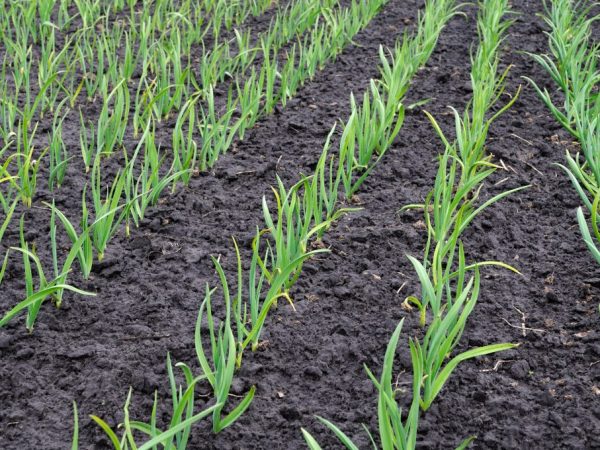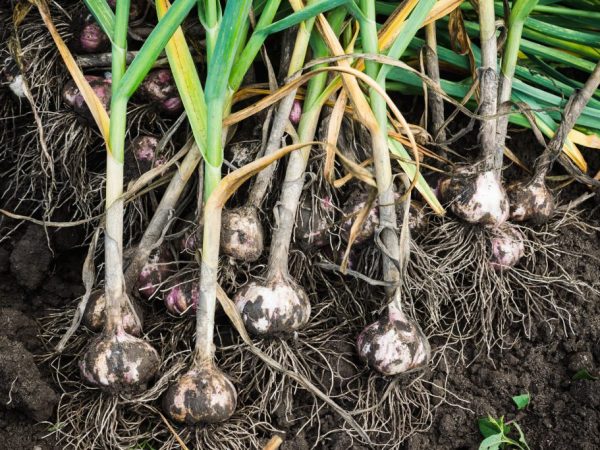Processing yellowing garlic
Sometimes the leaves of the garlic begin to turn yellow. Let's consider the reasons for the appearance of such a problem and how the yellowing garlic is processed correctly.

Processing yellowing garlic
Causes of yellowing of garlic
If the stalks of the garlic do not develop properly and begin to turn yellow, you need to figure out what triggered the problem. There are several reasons:
- temperature drops;
- improper watering;
- diseases and pests;
- lack of trace elements.
Temperature drops
Garlic is badly affected by frost. This happens in the following cases.
- Landing too early. There are recommended planting dates for each crop. If you plant garlic earlier, it will sprout before winter. When the cold comes, the leaves will freeze, and in the spring they will turn yellow.
- Frost in winter or spring. If a young garlic feather is frozen, the yellowing process begins. To minimize the influence of cold temperatures, the soil is mulched in the fall. Fallen leaves are suitable for this. The thicker their layer, the better the culture is protected from the negative effects of frost. The same advice can be given to keep the onion from freezing.
If, nevertheless, it was possible to protect the plant from the cold, the stem is sprayed with stimulants, such as Epin, Zircon, Energen. They will contribute to the development of the bush.
Improper watering

Due to drought, the feather of garlic turns yellow
Insufficient watering causes the stem to turn yellow. Garlic is watered regularly. Particular attention is paid to this in May and June, because it is then that the bush is formed.
In the spring, when the snow melts, the condition of the soil is checked. The soil near the garlic is loosened and looked at how moist it is. If the amount of moisture is insufficient, the plant is regularly watered.
If the soil is excessively wet (if the bed is close to a body of water), there is a need for drainage channels along the rows of bushes.
Do not over-water the garlic: this also contributes to the yellowing of the leaves. This usually happens if the soil is clayey on the beds. In this case, moisture can stagnate in the ground.
Water for irrigation is taken from the settled. It must be preheated in the sun. If the weather is not very hot, there is precipitation, they use about 10 liters of water per 1 sq. m of soil.
During heavy rains, air access to the roots is disrupted. To avoid this, the soil is loosened, and then slightly moved away from the bulbs. This frees up space and provides oxygen to the upper bulb. Leaves are also tied. Thanks to this, nutrients are better supplied to the bulb.
Diseases and pests
The following diseases and pests are most common:
- Fusarium. Disease of a fungal nature. It usually develops at high air temperatures, high humidity, with dense soil, as well as a lack of nutrition for the bushes. To avoid fungal infections, garlic cloves can be treated before planting. A solution of potassium permanganate and drugs such as Maxim and Fitosporin are suitable. You should study their instructions for use.
- Downy mildew.A disease that also occurs in hot weather and high humidity. In the fight against it, iodine milk, horsetail decoction, and ash brew help. The stems are sprayed with these means. They also use special drugs: Gamair, Vitoplan, Fitosporin-M. They must be used according to the instructions.
- Onion fly. A pest that infects leaves on bushes. If small worms are visible on the leaves, these may be the larvae of this insect. In this case, it is necessary to treat the leaves with a saline solution. To do this, 200 g of sodium chloride is dissolved in 10 liters of water.
- Stem nematode. This is a worm that lives in the ground for a long time and lays eggs on plants. The best solution in this case is to destroy the plant and plant it in another garden next year.
Lack of micronutrients
In the soil, there is often a deficiency of potassium and nitrogen, as a result of which the leaves of garlic turn yellow.
With a lack of nitrogen, organic or mineral fertilizers are used. In mineral fertilizers, the concentration of nutrients is higher, so you should be especially careful with them, strictly follow the instructions. Top dressing is carried out in the spring. If this is done in the fall, the fertilizer will be washed out before spring. You can also use the following solution: 20 g of urea in 1 bucket of water. Plants are watered at the rate of 10 liters per 1 m.
For potassium deficiency, foliar feeding is a good option. It is advisable to carry out the procedure at the very beginning of plant growth. You can apply a complex mixture. Potassium chloride is also used in a proportion of 10 g per 1 liter of solution. It is desirable that the weather be clear and calm. The agent is sprayed on the ground near the bushes.
Another option is the use of ash. Take 100 g of ash per 1 m. The solution is well suited for acidic soil. Manure is also used. You need 100 kg of manure per 100 m of soil.
Conclusion
The yellowing of garlic is one of the problems many gardeners have to deal with. It is important to identify the cause of this phenomenon, then the fight against yellowing will give a result.


